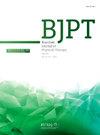俯仰速度与肘关节内翻力矩之间的关系
IF 3.2
3区 医学
Q1 ORTHOPEDICS
引用次数: 0
摘要
虽然生物力学在棒球领域的研究和应用越来越多,但在提高成绩和减少伤害之间仍然存在二分法。目的探讨在控制俯仰速度的情况下,哪些变量对肘关节内翻力矩影响最大。次要目的是评估从确定的生物力学变量导出的最小数据集预测模型。方法对接受生物力学评价的棒球投手进行回顾性分析。利用协方差分析和预测模型对内翻力矩和快球速度进行了分析。结果共纳入298名投手。髋肩分离对数(0.12 (95% CI: 0.01, 0.23), R2=0.10),躯干最大旋转速度(0.42 (0.15,0.70),R2=0.12),球体释放时躯干屈曲(-0.11 (-0.20,-0.02),R2=0.10),和弯曲后肩部外展(-0.29 (-0.52,-0.06),R2=0.10)与肘关节内翻扭矩对数之间存在较小的关联。肘关节内翻扭矩的临床预测模型使用最小预测变量导致预测性能差、校准和误差大(RMSE=1.15, R2=0.10,校准=0.78(0.41,1.15))。结论通过改善俯仰传递过程中的小方面来优化俯仰效率有可能在保持较低内翻力矩的同时实现速度的提高。本文章由计算机程序翻译,如有差异,请以英文原文为准。
Association between pitching velocity and elbow varus torque
Background
While there has been an increase in the number of biomechanical studies and usage across baseball, there often remains a dichotomy between performance enhancement and injury reduction.
Objective
To identify which variables have the highest influence on elbow varus torque while controlling for pitch velocity. The secondary purpose was to evaluate a minimal data set prediction model derived from the identified biomechanical variables.
Method
A retrospective review was performed on baseball pitchers who underwent biomechanical evaluation. Analysis of covariance and prediction modeling for varus torque and fastball velocity were utilized.
Results
298 pitchers were included. Small associations were identified between the log of hip shoulder separation (0.12 (95 % CI: 0.01, 0.23), R2=0.10), maximum trunk rotation velocity (0.42 (0.15, 0.70), R2=0.12), trunk flexion at ball release (-0.11 (-0.20, -0.02), R2=0.10), and shoulder abduction at late cocking (-0.29 (-0.52, -0.06), R2=0.10) in relation to the log of elbow varus torque. The clinical prediction model for elbow varus torque resulted in poor prediction performance, calibration, and large error using minimal predictor variables (RMSE=1.15, R2=0.10, Calibration=0.78 (0.41, 1.15)).
Conclusion
Optimizing pitching efficiency by improving small aspects throughout the pitching delivery has potential to accomplish an improvement in velocity while maintaining lower levels of varus torque.
求助全文
通过发布文献求助,成功后即可免费获取论文全文。
去求助
来源期刊
CiteScore
6.10
自引率
8.80%
发文量
53
审稿时长
74 days
期刊介绍:
The Brazilian Journal of Physical Therapy (BJPT) is the official publication of the Brazilian Society of Physical Therapy Research and Graduate Studies (ABRAPG-Ft). It publishes original research articles on topics related to the areas of physical therapy and rehabilitation sciences, including clinical, basic or applied studies on the assessment, prevention, and treatment of movement disorders.

 求助内容:
求助内容: 应助结果提醒方式:
应助结果提醒方式:


